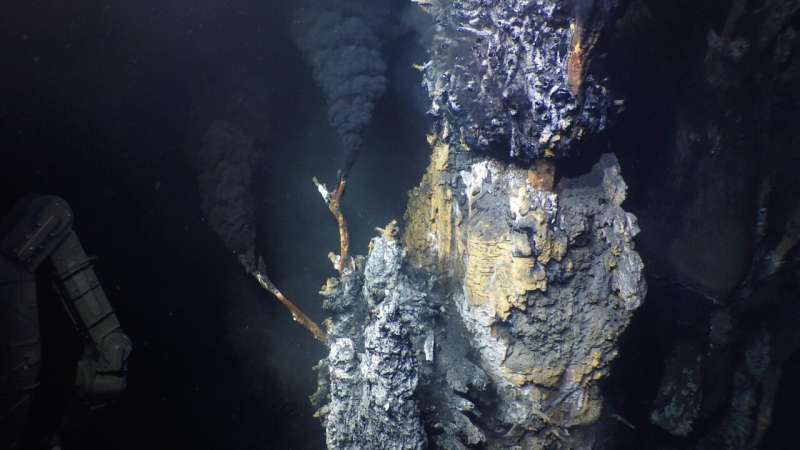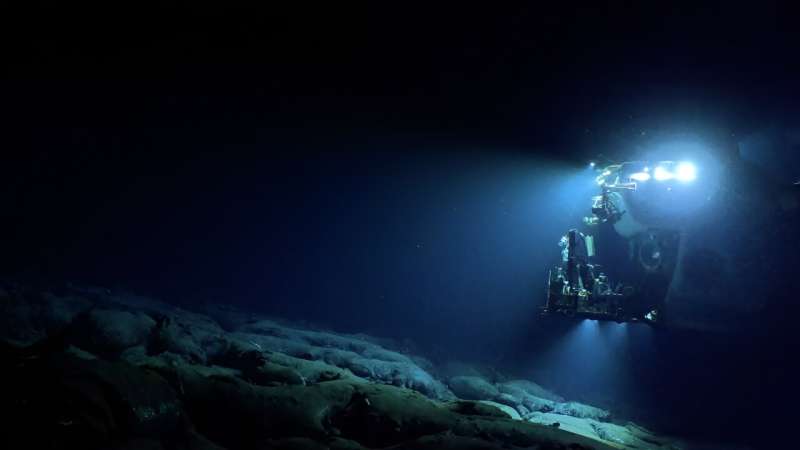This article has been reviewed according to Science X's editorial process and policies. Editors have highlighted the following attributes while ensuring the content's credibility:
fact-checked
trusted source
proofread
Five new hydrothermal vents discovered in the Eastern Tropical Pacific Ocean

The pace of discovery in the oceans leaped forward thanks to teamwork between a deep-sea robot and a human occupied submarine leading to the discovery of five new hydrothermal vents in the eastern Tropical Pacific Ocean.
Late last week, ocean scientists aboard the research vessel Atlantis returned to port in San Diego from a research expedition in the eastern Pacific Ocean. There, the team discovered the new deep-sea hydrothermal vent sites on the seafloor at 2,550 meters (8,366 feet, or 1.6 miles) depth. The venting fluids are all hotter than 300°C (570°F). The discovery was supported, and in many ways accelerated, by making use of the unique strengths offered by robotic and human exploration of the deep seafloor.
The newly discovered vents are located on the East Pacific Rise (EPR) near 10°N latitude, a part of the globe-spanning mid-ocean ridge volcanic mountain chain, where two tectonic plates are splitting apart at a rate of about 11 centimeters (4.3 inches) per year. Scientists on the expedition mapped the area at night using the undersea robot Sentry, an autonomous underwater vehicle (AUV) operated by the Woods Hole Oceanographic Institution's (WHOI) National Deep Submergence Facility (NDSF).
After Sentry was recovered each morning, high-resolution maps from the vehicle's sensors were then used to plan the day's dive by the human-occupied vehicle Alvin also operated by WHOI-NDSF, which enables scientists to view firsthand the complex and constantly changing environment of a place like the East Pacific Rise.
"The high-resolution maps from Sentry allow us to spot likely new hydrothermal fields soon after Sentry comes back on deck," said Lehigh University's Jill McDermott, Chief Scientist of the expedition and co-lead scientist specializing in hydrothermal vent geochemistry. "This gives us great targets for Alvin and the opportunity to make multiple discoveries in a single dive."

Scientists diving in Alvin first discovered hydrothermal vents in 1977 while exploring an oceanic spreading ridge north of the Galápagos Islands. Hydrothermal vents are rich in chemicals that supply energy to animal life, fueling rich and productive ecosystems. The discovery re-shaped scientists' understanding of the conditions capable of supporting life on Earth and potentially elsewhere in the solar system.
The research program at EPR is focused on learning more about volcanic and hydrothermal systems in the deep-sea where new seafloor is formed and where unique communities of animals thrive in high-pressure and high-heat environments.
"The mid-ocean ridge accounts for more than 75% of all volcanic activity on our planet," said Thibaut Barreyre, a co-lead scientist on the expedition from CNRS, Univ Brest, France and an expert in thermal measurements and modeling of hydrothermal vents. "It is dotted with thousands of deep-sea hot springs like these, which all together extract 10% of the Earth's total internal heat. We want to increase our understanding of how hydrothermal vents release heat and chemicals as they flow through the seafloor and affect the global ocean."
"The new Sentry maps allow us to see the very important details of lava flows that erupted in the deep ocean and target them for collecting rock samples, just like geologists do on land," said Daniel Fornari, a co-lead scientist on the expedition from WHOI and a marine geologist who has been involved in EPR research for more than 40 years.
"These new perspectives and the analyses of rock samples will let us figure out how quickly the lava erupted, how far it traveled, and the impacts deep sea lava eruptions have on hydrothermal venting."
"By jointly operating these two cutting-edge deep-sea submersibles, we are able to make remarkable new discoveries about how seafloor in the deep oceans is constructed, in some of the most inhospitable environments on Earth," said Ross Parnell-Turner, a co-lead scientist on the expedition from UC San Diego's Scripps Institution of Oceanography and a marine geophysicist specializing in high-resolution seafloor mapping of the volcanic and hydrothermal terrain.
Scientists plan to continue studying hydrothermal activity and volcanism along the East Pacific Rise in a follow-up expedition that will also use Sentry and Alvin to expand their understanding of the geophysical, chemical, and biological processes that shape our planet and support life in the deep, dark recesses of Earth's Ocean.
Provided by Woods Hole Oceanographic Institution




















